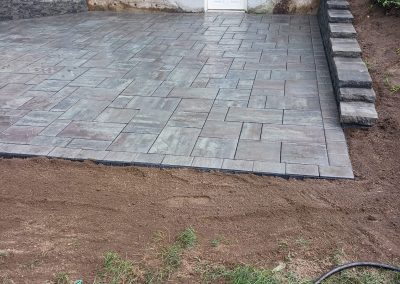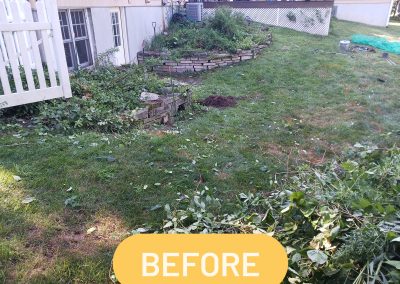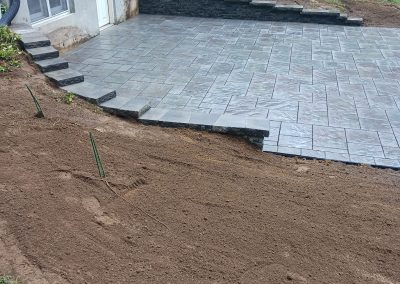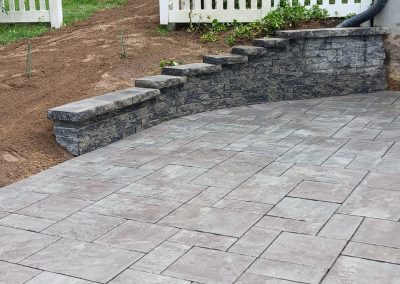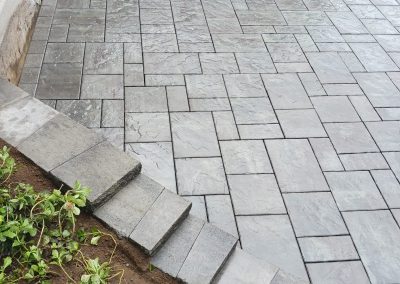Environmental Design an Landscaping recently completed a retaining wall and stone paver patio installation project in Chicopee, MA. This is a common landscaping and hardscaping project that can enhance the functionality and aesthetics of your outdoor space. Here’s a step-by-step guide to help you understand the process:
Retaining Wall Installation in Chicopee, MA:
- Planning and Design:
- We begin by assessing your property and identifying the need for a retaining wall. This could be to prevent erosion, level sloping terrain, create terraced gardens, or add structural support.
- Determine the wall’s purpose, size, design, and the choice of materials (e.g., concrete blocks, natural stone, timber).
- Permit and Regulations:
- Check with local authorities to see if any permits are required for the retaining wall project. Ensure that the design and construction comply with local building codes and regulations.
- Site Preparation:
- Excavate the area where the retaining wall will be built, creating a level and compacted base.
- Install proper drainage systems behind the wall to manage water flow and reduce pressure on the structure.
- Material Selection:
- Choose the type of materials for your retaining wall. The choice will affect the wall’s appearance, strength, and cost.
- Construction:
- Begin construction according to the approved design plan, stacking and securing the chosen materials.
- Ensure the wall is level, plumb, and properly reinforced (if necessary).
- Properly backfill and compact the soil behind the wall as it is built.
- Finish and Aesthetics:
- Add finishing touches, such as capstones or veneers, to enhance the wall’s appearance.
- Drainage and Backfilling:
- Install proper drainage systems to manage water runoff.
- Backfill behind the wall with gravel to encourage drainage.
Stone Paver Patio Installation in Chicopee, MA:
- Design and Layout:
- Create a design and layout for your stone paver patio, considering the size, shape, and pattern of the pavers.
- Mark the area for excavation.
- Excavation and Base Preparation:
- Excavate the area to the desired depth, ensuring a level surface.
- Create a stable and properly graded base using crushed stone or gravel. Compact the base thoroughly to prevent settling.
- Edge Restraints:
- Install edge restraints, which are typically made of plastic, metal, or concrete. These keep the pavers in place and prevent them from shifting.
- Sand Bed Installation:
- Lay a layer of bedding sand over the compacted base. This will provide a smooth and level surface for the pavers.
- Paver Installation:
- Carefully lay the pavers in the desired pattern, leaving small gaps (usually about 1/8 inch) between them for jointing sand.
- Use a rubber mallet to ensure the pavers are level and secure.
- Jointing Sand:
- Fill the gaps between the pavers with jointing sand and then use a compactor to settle the pavers and sand.
- Edge Restraint and Finishing:
- Install the final edge restraints and compact the entire patio again.
- Clean and Seal:
- Clean the pavers and then apply a sealer to protect the surface and enhance the color.
Both retaining wall and stone paver patio installations are complex projects that may require the expertise of a professional contractor, particularly if they involve structural support, precise grading, or intricate design elements. Hiring Environmental Design an Landscaping ensures that the work is done correctly and complies with local building codes.
You can click the following link to View Our 5-Star Google Reviews, and please do not hesitate to ask us for references! You can contact us today at (413) 525-3712 to schedule a quick no-cost quote!



